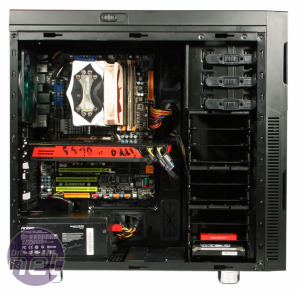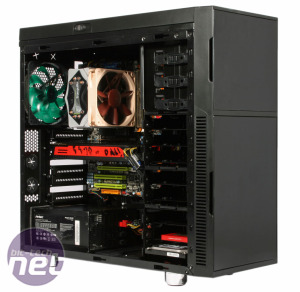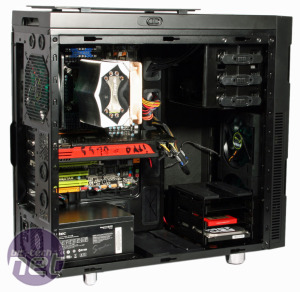
Performance Analysis
We tested the DS1 in its default configuration, as well as in a ventilated configuration with the modular cages removed and the chimney open. In both of these setups, we tested at the highest and lowest fans speeds for a total of four tests. Regardless of the fan speed or the chimney position, the noise levels from the DS1 were astoundingly low, ranging from near silent to incredibly quiet. The case fans were so quiet that we had to check whether or not they were actually spinning any quicker as we increased the fan speed, indicating that unsurprisingly their airflow is somewhat limited.Both the GPU and CPU temperatures were positively affected by upping the fan speed and increasing the ventilation, but sadly this only reduced the temperatures from awful to pretty bad. In its optimum state, the case achieved a CPU delta T of 56°C and a GPU delta T of 51°C, which are both among the lowest we've seen. These results are similar to other low noise cases like the R4 (on low speed) and the Corsair 550D (with its panels closed), but these two cases both trump the DS1 in their own optimum states.
The GPU benefits from the increased ventilation and the higher fan speeds equally. Improving one or the other drops its delta T of 55°C by 2°C in each case, and improving both reduces it by 4°C, demonstrating that higher airflow fans in the front of the case would improve its temperatures dramatically. Our CPU enjoys the increase in fan speed more than it does the opening of the Air Chimney, with the rear exhaust fan being key to evacuating heat from this hotpot. That said, despite our pessimism, the chimney clearly has an effect too, allowing a bit more of the trapped heat in this area to escape.


Click to enlarge - Excellent cable management options allow you to tidy your cables very effectively
Conclusion
For its first entry into the case market, Nanoxia have sensibly mimicked the popular design of the R4 in many ways, but have added their own improvements too. An extra fan out of the box is always a plus, and the fan control is also better with the DS1. With a more versatile modular drive mounting system and a improved front fan and radiator mounts, the Nanoxia case really has a lot going for it. We have to admit we're excited to see what Fractal come up with in response to the next iteration of the Define series.Sadly, the DS1 won't stop you waiting for that miracle case that remains near silent but provides excellent cooling too, but you shouldn't dismiss it entirely. It's feature rich, sensibly designed and fairly priced, although we'd argue it still doesn't quite match the levels of elegance and refinement of the R4. If cooling a toasty overclocked rig is the most important thing to you, you'll want to give it a miss. However, if you want quiet, the Nanoxia case is still a great choice.
**It has come to our attention that the information initially provided about the water-cooling support was incorrect, and as such the last paragraph on page 2 of the review has been updated, and the design score slightly adjusted to reflect this**
-
Cooling14 / 30
-
Features19 / 20
-
Design28 / 30
-
Value17 / 20


MSI MPG Velox 100R Chassis Review
October 14 2021 | 15:04









Want to comment? Please log in.